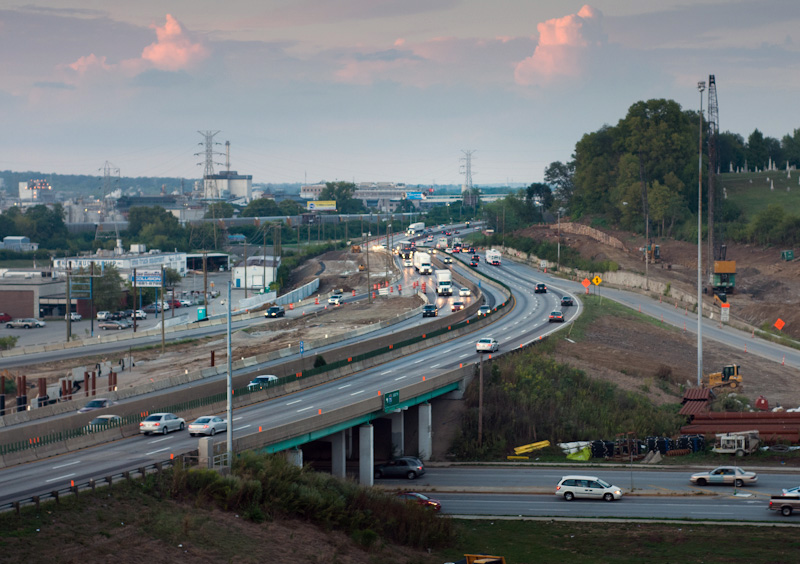In the early 2000s the Ohio Department of Transportation (ODOT) formulated plans to rebuild and widen Interstate 75 between the Ohio River and I-275. The overall plan was divided into three project areas: The Brent Spence Bridge, Millcreek Expressway (Downtown north to Paddock Road), and Thru the Valley (Paddock Road north to I-275).
Originally all fifteen miles of work were expected to be completed by 2020, but ODOT’s financial crisis has meant just three of the 17 phases comprising the Millcreek Expressway and Thru the Valley sections have commenced construction. The complex character of the planned reconstruction means some phases must be built before others but little benefit to safety and traffic capacity will be realized until nearly all sections are complete.
September 2012 I-75 reconstruction photographs by Jake Mecklenborg for UrbanCincy.
In short, work currently underway will build retaining walls and build new overpasses for an expanded highway, but the expressway itself cannot be widened in these areas until adjacent phases are completed. So improvements currently under construction at Mitchell Ave. might be decades old before they are put to full use – or worse, these future phases might never be built.
Thus far, ODOT has only completed the $7.1 million second phase which rebuilt the Monmouth Street overpass in Camp Washington. Originally planned to be built as part of Phase 5 (Hopple Street to Mitchell Avenue), the Monmouth Street Overpass was deemed “shovel-ready” and funded through the American Recovery & Reinvestment Act of 2009.
The $53 million reconstruction of the Mitchell Avenue Interchange (Phase 1) began in 2011. Construction crews are presently demolishing the 57-year-old Mitchell Avenue and Clifton Avenue overpasses and preparing the right-of-way necessary to widen I-75 from six to eight lanes.
ODOT has scheduled a summer 2014 completion for the Mitchell Avenue work.
Modification of the Colerain/Beekman/I-74 Interchange (Phase 3) also commenced in 2012. This $13 million project is also currently taking place, and is also scheduled for completion in 2014.
An ODOT official explains what led to the financial troubles of ODOT at a Transportation Review Advisory Council meeting in 2011. Video by Jake Mecklenborg for UrbanCincy.
Yesterday ODOT Director Jerry Wray announced funding for the first phase of the $467 million Thru The Valley project. Although funding is now programmed for reconstruction of I-75 between Shepard Lane and Glendale-Milford Rd. beginning in 2021, there is still no definite timetable for the Thru the Valley’s other 7 phases.
These delays in work on I-75 in Cincinnati illustrate the central problems with state and federal gasoline taxes: the taxes are not automatically adjusted with inflation, causing revenues to drift downward over time, and proceeds fall when high gas prices motivate people to drive less. Until either or both gasoline taxes are raised, or ODOT identifies new funding sources, reconstruction and widening of I-75 will proceed at a glacial rate, and drivers will realize little benefit from completed early phases.
